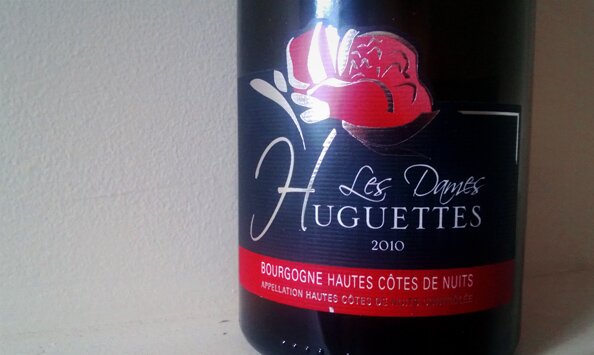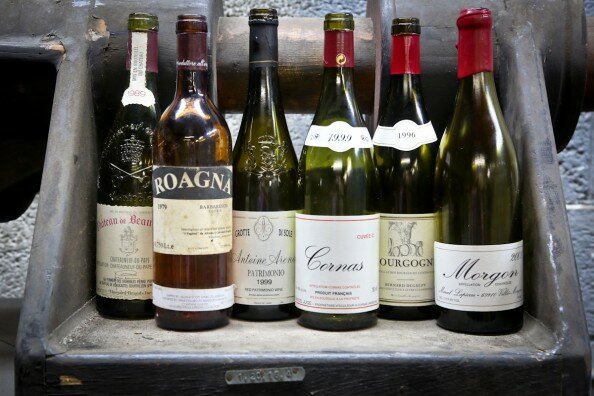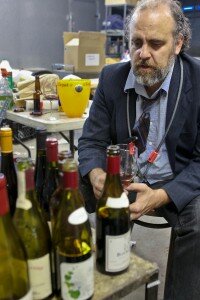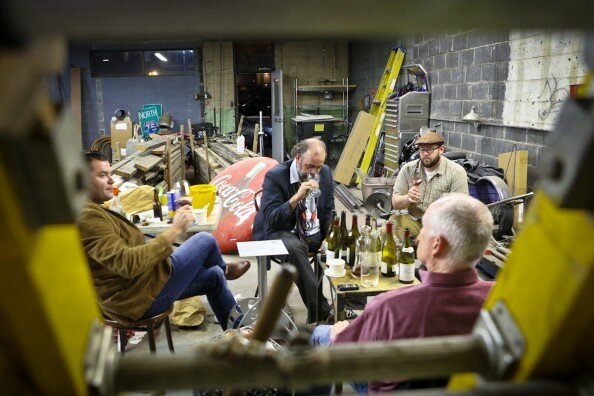
GUD BLOG
Some Beautiful 2010 Burgundy

Good burgundy is magical. It occupies more room in my cellar than any other wine, I think about it more than any other wine, and I do genuinely enjoy it more than any other wine. But of course, good burgundy is also really fucking expensive.
Well, most of the time.
Fortunately, Evan Barrett at Plum Market in Bloomfield was recently selling a nice bottle for me to fawn over. From a somewhat unheralded parcel of land called Les Dames Huguettes, this isn’t fancy stuff. The vineyard is from the Hautes Cotes du Nuits, which is a stretch west of northern burgundy known mostly, I believe, for making cheap plonk that ends up on supermarket shelves under the faded, laminated sign that says “FRANCE.”
By contrast, Les Dames Huguettes is, as I understand it, the only chunk of land in the Hautes Cotes for which the name may appear on the label. In other words, the French wine police think it’s not exactly a shitty place to grow grapes for wine. I agree.
This particular bottle is young and juicy, full of fruit. But there’s a lot of acid to it. It’s a very delicious, natural fruit flavor. Incredibly fresh stuff with a nice mineral edge and a finish that lingers. This is seriously delicious. And for around 30 bucks (or so), it’s a very reasonably price for entry level burgundy.
The label struck me as kind of odd and whimsical, so I was surprised by the seriousness of what’s in the bottle. As it so happens, this is produced by Domaine Mongeard-Mugneret, a classic burgundy producer with wines from some of the most sought after grand crus in all of burgundy. So I guess they’re actually slumming it a bit, but hey, good for us.
Those who attended our “Wine Soak” tasting back in April would recognize similarities between the burgundy we tasted there and this bottle. Both from 2010, each wine has the same incredible transparency through the wine to the fruit itself, despite the fact they’re both inexpensive wines. And despite the allegedly less-than-stellar vintage, which was wrought with frost problems leading to dead vines and low yields. But the wines I’ve tasted from that year are spectacular in exactly the same way. I’ve seen plenty of wine critics online indicate that the best winemakers quietly had standout years in 2010 with beautiful, elegant wines, and it’s hard to disagree based on my limited experience.
Anyhow, if there’s any of this left around Michigan, burgundy lovers who aren’t so much blessed with the fat ass pocketbooks should grab some while they can.
2013.09.20 Evan Hansen at 5:45 pm | Be the first to comment
Wine Soak @ Signal-Return: Introduction to French Red Wine
It’s been a while in the making but a new Wine Soak event is finally here! We’re going to be drinking some kick-ass wines in a very cool space. Details are posted below.
http://www.eventbrite.com/
Wine Soak @ Signal-Return: Introduction to French Red Wine
When: 6:30 p.m. – 8:30 p.m., Thursday, April 25th
Where: Signal-Return – 1345 Division Street in Detroit’s Eastern Market
What’s the difference between the Loire Valley and the Rhone Valley? How is it that Languedoc-Rousillon produces a third of all wine in France yet you don’t see many bottles from this region on the wine store shelf? Why do some Burgundy and Bordeaux sell for hundreds of dollars a bottle? Does all Beaujolais smell like bubble gum? (No!) Can you find a good wine from any of these regions without taking out a loan? (Yes!)
We’ll explore these and other questions while hanging out and drinking at Signal-Return, a working letterpress studio that offers workshops and open studio time in the historic Eastern Market district. Our team of talented drinkers will select a specific red wine to represent each of six different regions of France: Beaujolais, Bordeaux, Burgundy, Languedoc, Loire, and Rhone. Each region will have its own short presentation, followed by open discussion.
If you’re hip to discovering new wine in a casual environment with a fine group of people, Wine Soak is where it’s at.
Wine Soak: Introduction to French Red Wine will be held on Thursday, April 25th at 1345 Division Street in Detroit’s Eastern Market. Doors open at 6:30 p.m. Presentations will begin at 7:00 and end at 8:30. Limited seating is available for the ridiculously low price of only $30 per person. Cost includes a pre-game glass of sparkling wine, 2 oz. pours of six different wines, and pizza from Supino Pizzeria.
Wine Soak is a wine tasting and discussion series designed for all levels, from novice to professional. Each event covers a different varietal, region, or theme, with a brief review of wine basics, sampling of six to eight different wines, and a rotating venue. No posing. No bullshit.
Special thanks to Southeast Michigan’s Premier Merchant of French and Spanish Wine since 1992, Elie Wine Company.
2013.03.05 Todd Abrams at 9:50 am | Be the first to comment
Tasting Notes from the Cellar

There are lots of ways to put together a collection of older wines. Collect and store them in a cellar, buy them from a reputable merchant who has stored them, steal them from a friend, find a store that has found a so-called library release of wines aged at the winery, et cetera. Each of these methods (Except stealing. I think.) were put to use a couple weeks back when a group of us got together to drank some older wines.
A few notes, recorded for posterity’s sake…
1979 Roagna Barbaresco
Delicious from the start, this might have been my favorite wine of the evening, opening up to a beautifully tart and fruity wine with very noticeable spicy and herbal undertones. Tarragon? Mint? Tobacco? Umami? A really nuanced wine that moved from being a bit tannic to downright light and lively. As Todd said, the “most complete wine” of the evening.
1989 Beaucastel, Chateauneuf de Pape
Earthy and big to start, it finished with an edge that smoothed out and opened up over time. A little funk early on that blew off quickly. Lots of fruit, though, even from the onset. Steve observed it might be on the downside of its life. But after a couple of hours, the leather and tannin subsided a bit. Pretty classic; a fine drink.
1999 Antoine Arena, Patrimonio
Dark, deeply colored, full of sediment, brooding aromas to start. Dirty, tannic, earthy wine. Some minerality and acid. Looks brooding, full of flavor, but surprisingly youthful. I wish I’d taken more detailed notes, but the general sentiment was that this was in a good place. Steve observed in retrospect that it was hard to wrap his head around this, and I agree: It was the biggest of the all and came late in a long night of drinking.
1990 Bongran Macon Clesse
 Remarkably unique. Truly. Drew a chorus of quizzical looks and comments. Todd described the aromatics as being a lot like coffee beans, and Putnam began to latch onto that as a descriptor for the flavor as well. I think I see what they were getting at in terms of a the long, slow, earthy quality of the fruit. Floral and honey notes. Not sweet but clearly botrytized grapes. Lots of tropical fruit but not of the predictable sort found in so many overly engineered wines. Some in the group felt it would be hard to drink this in any serious quantities, me among them, but it’s hard to deny its brilliance.
Remarkably unique. Truly. Drew a chorus of quizzical looks and comments. Todd described the aromatics as being a lot like coffee beans, and Putnam began to latch onto that as a descriptor for the flavor as well. I think I see what they were getting at in terms of a the long, slow, earthy quality of the fruit. Floral and honey notes. Not sweet but clearly botrytized grapes. Lots of tropical fruit but not of the predictable sort found in so many overly engineered wines. Some in the group felt it would be hard to drink this in any serious quantities, me among them, but it’s hard to deny its brilliance.
1996 Dugat-Py Bourgogne Rouge
I wonder what this cost on release. No famed crus on the label. Just good wine in the bottle that has lasted until now. Light, refreshing, but still structured. As Putt said, it’s “chuggable.” Of course, Putt thinks whiskey is “chuggable.” But still, I tend to agree. We also had a 1995 Marechal Pommard, and the Dugat-Py was in a far better place. The other was gnarled and dare I say backward whereas this was simply pretty.
1999 Juge Cuvee C Cornas
Coming after a puckeringly tart Morgon and even the Chateauneuf, this was downright jammy. Young and fruity. A nice dose of acid, but compared to other wines, this really seemed sweet. Delicious but didn’t really suck me in the way some others did.

2012.11.27 Evan Hansen at 8:37 pm | 1 Comment

Chateau Thivin Cote de Brouilly: Why This $20 Wine is Better
I’m always trying to sniff out bottles of wine that supply the most gratifying drinking experience for the price. Some people call these “value wines”.
But it ain’t easy.
The vast majority of wine under $10/bottle is made to be consumed immediately and with little fanfare. In this price range you’re going to find a lot of idyllic back label stories that read like tourist guides to the Elysium Fields. The truth is — and here you can make an honest comparison to the realm of domestic beer — as many beer-only drinkers find their ice-cold American lager brand of choice to be a flawless beverage no matter what the situation, some wine drinkers will swear by $6 bottles of perfectly unremarkable chardonnay. That’s fine if you just want to catch a buzz.
At a local Indian restaurant that “allows” BYOB, I watched as a threesome were seated and one of their party subsequently pulled out a bottle of white zinfandel and two cans of Busch Light from his jean jacket. It seems to me that if you’re going to surrender your taste buds to the relatively exotic flavors of the Indian Subcontinent, you ought to at least have a simple Riesling or a malty Pilsener to wash it all down. This merely illustrates that most of the time familiarity rules — especially when the price is right.
You can find a wine with character for $10-$15. A value wine. One that pops into mind is Domaine de la Fruitière Chardonnay. Here is a dry, white wine that probably won’t change your philosophy but it does combine the richness of chardonnay with the crisp mineral structure of traditional Muscadet, and when slightly chilled, drinks agreeably in the shade of an oak tree near your favorite swimming hole on a warm July day. If you’re one of those aforementioned, strict chardonnay drinkers, here is a risk-free way to expand your palate.
If you are a wine enthusiast with a limited budget and a desire to learn, the $15-$25 range is ripe with good wine of character. This is your sweet spot. Unfortunately, there is also a lot of ordinary wine with large brand marketing budgets in this group. A trustworthy wine merchant is vital to lead the way here.
The trustworthy wine merchant is going to carry things like Château Thivin Côte de Brouilly for a little less than $25. But what makes this particular wine better? Why is it three times the price of Yellow Tail merlot?
The reasons are many. For one, it’s drinkable. I have consumed at least a half dozen bottles of this wine in the past few months with different people. With the exception of one person that was exceedingly sensitive to tannins, we all loved it. But drinkable does not mean simple. A glassful is all berries and flowers and wet stones. It’s tart and refreshing, with a minerality that grips at the finish. There is an integration of aromas, textures and flavors that elevate this wine well above the grocery store bottles. In short, it tastes like more than just fermented fruit juice.
Secondly, it’s from somewhere. Part of the pleasure derived from fine wine is creating a connection to a place. In this case we can identify it from the Beaujolais winemaking region of France. Further, it is from Brouilly, one of ten Cru Beaujolais, (the highest category of classification in the region). Even further, this wine is from vineyards in the sub-district of Côte de Brouilly, from the steep slopes of Mont Brouilly, where the soil is composed of volcanic blue stone. It’s kind of like one of those international espionage movies that zoom into a spot on earth from a satellite camera in orbit, except we witness a grape farmer tending his vines, not the assassination of a high level diplomat.
And finally, for the enthusiast, it’s educational. Compare this wine to other Cru Beaujolais in the same price range. Because all are made from gamay grapes, you begin to get a sense of how climate and soil can affect the finished wine (terrior!). And because Cru Beaujolais can sometimes develop over three to ten years, you can afford to let a few of these sit in the cellar and see how they change with time.
A typical question from wine novices when confronted with wine prices ranging from $3 to $300 is: Do you get what you pay for? I’ve struggled with this question myself after I decided I that I really, really like wine. A lot. And I still struggle. The general answer is complex and can include things like hand-harvesting, barrel-aging. Both of which are applied to Château Thivin Côte de Brouilly. So, in this case, I believe it’s a resounding yes. Buy some and invite me over for drinks.
2012.11.02 Todd Abrams at 2:00 pm | 2 Comments
Curious Foods of the North – Stories behind some of northern Michigan’s most popular fare.
Driving East on U.S. Highway 2 through Michigan’s Upper Peninsula between Naubinway and St. Ignace you are sure to see three things: a crystal blue Lake Michigan to your right, thick evergreen and hardwood forest to your left, and ahead, signs for pasties, smoked fished and fudge. How did these three distinct foods come to symbolize the north?
A Moveable Feast
Although regrettably sharing the same name as decorative nipple coverings, Michigan pasties are much tastier. Similar to pot pies but without the pot, these portable meals were a favorite of immigrants working Upper Peninsula mines before they were standard tourist fare.
Introduced in the 19th Century by Cornish miners, the hearty pasty could easily be eaten end to end, without knife or fork, and even reheated on a shovel held above a headlamp candle. Finns and Swedes, who were also working the mines, contributed their own culinary influences to the UP pasty.
The mining industry eventually collapsed but the UP pasty remained. Today, you can find pasties filled with chicken, fish, or simply vegetables. Some places will smother them in tomato sauce and melted cheese. You can even find them “Mexican style”.
The most satisfying UP pasty is filled with beef and diced vegetables (we like it with earthy, sweet rutabaga), has a solid crust, and comes with a cup of brown gravy on the side. It is best eaten on a chilly autumn day while the wind whips the Mackinac Straights into a white froth. A couple glasses of whiskey as digestif are optional though highly recommended.
Are You Calling Me a Fudgie?
The world is flooded with candy that has been processed and packaged in factories then shipped to corner convenience stores. But in Mackinac it’s old school copper kettles, marble tables, and sweet cream.
Every batch of fudge is handmade. When the syrup reaches what candymakers call the “soft ball stage” it’s poured onto marble and slowly manipulated with spatulas into logs. It’s said that this long cooling process, particularly during humid summer days, is what makes Mackinac fudge unique – its terroir, if you will.
True or not, this type of candymaking hearkens back to the days of people working with their hands and fits right into the wistful Mackinac Island experience where many a summer vacation memory has been made.
We prefer enjoying locally made fudge away from the throng of tourists in and around Mackinac. A short drive west is Wilderness State Park. Or head east to Cheboygan State Park. Both parks boast amazing forest and shoreline hiking opportunities. No better way to work off a giant hunk of fudge than a brisk few miles on foot, Bald Eagles soaring overhead.
Just Water, Salt and Smoke
It’s not so curious that a land and people surrounded by freshwater seas enjoy their fish. From Leland near the popular Sleeping Bear Dunes to remote Whitefish Bay to Houghton-Hancock and all points around and between, smoked fish finds its way into most every cabin in the northwoods.
Unlike thinly sliced lox that’s cold-smoked for preservation, northern Michigan fish are hot-smoked and thus the flesh is textured more like cooked fish. The process is simple. The fish, normally whitefish, salmon or trout, is brined in saltwater and placed in racks over smoldering logs. The wood used for smoking is often maple, another abundant local resource.
Though smoked fish can be made into a dip or even a sausage this classic northern Michigan dish is best enjoyed simply on a cracker. Pair it with a glass of crisp white wine, a lover, and the remains of a day gone orange behind the pines.
2012.09.27 Todd Abrams at 10:11 am | 1 Comment
Slideshow: The Next Urban Chef
Chef Andy Hollyday wandered out from behind his burners to check on our table, “How was everything?” We all nodded, our mouths full of food, and mumbled our appreciation. It’s a scene I’d witnessed several times, the chef taking a few moments to check in with his customers. Except generally, I’m seated at Roast, and Andy’s cooks are typically old enough to grab a beer after work.
Last Saturday, though, it was an entirely different setting: Andy’s kitchen was a range and a few tables in the corner of Eastern Market’s Shed 5, and his team consisted of a handful of local students participating in The Next Urban Chef, a food system education project put together by Detroiter Alison Heeres.
Hollyday joined Corrdor Sausage’s Will Branch, The Sunday Dinner Company’s Eric Giles, and Supino’s Dave Mancini as team leaders, about a dozen students learning and working under their guidance to learn about food, local agriculture, and teamwork.

The competition was judged, with each team preparing three dishes and their subsequent scores being allocated based not just on the food but on their ability to work together and their use of Michigan ingredients.
Hollyday’s team, which won the competition, besting reigning champ Dave Mancini, prepared sweet corn ravioli with shrimp, roasted chicken with an apple cider vinegar sauce and Swiss chard, and an apple rosemary tart with homemade vanilla ice cream. I’m fortunate enough to say that I tried all three courses, and Chef Andy and his students did a great job.
To learn more and be privy to info about next year’s event, check out their Facebook page.
2012.09.17 Evan Hansen at 9:21 pm | 2 Comments




